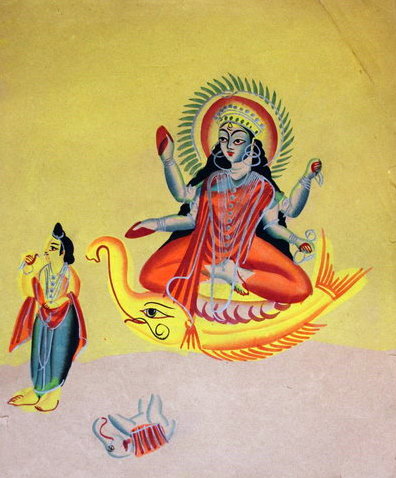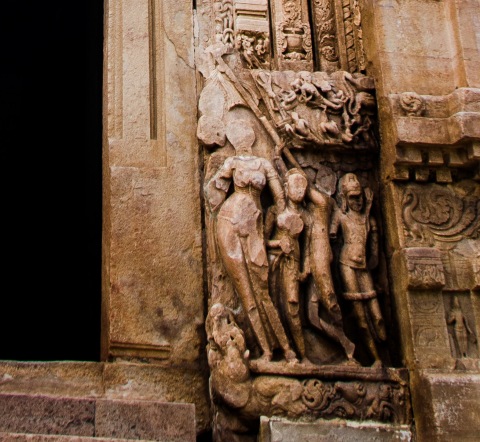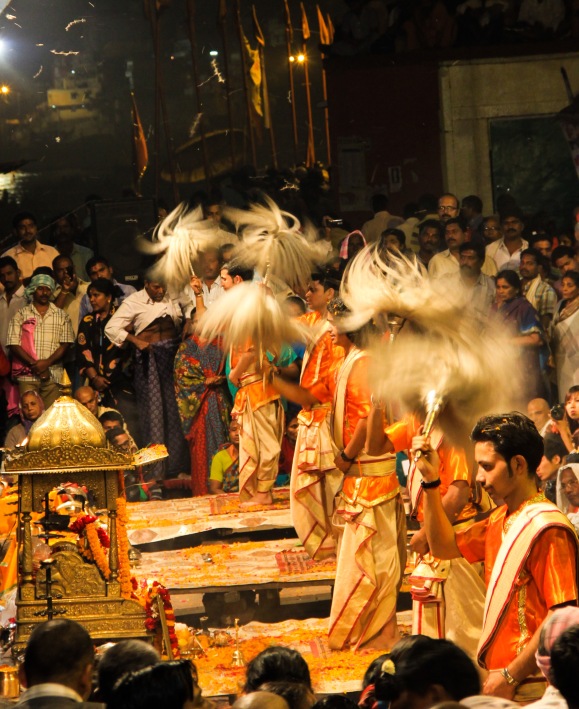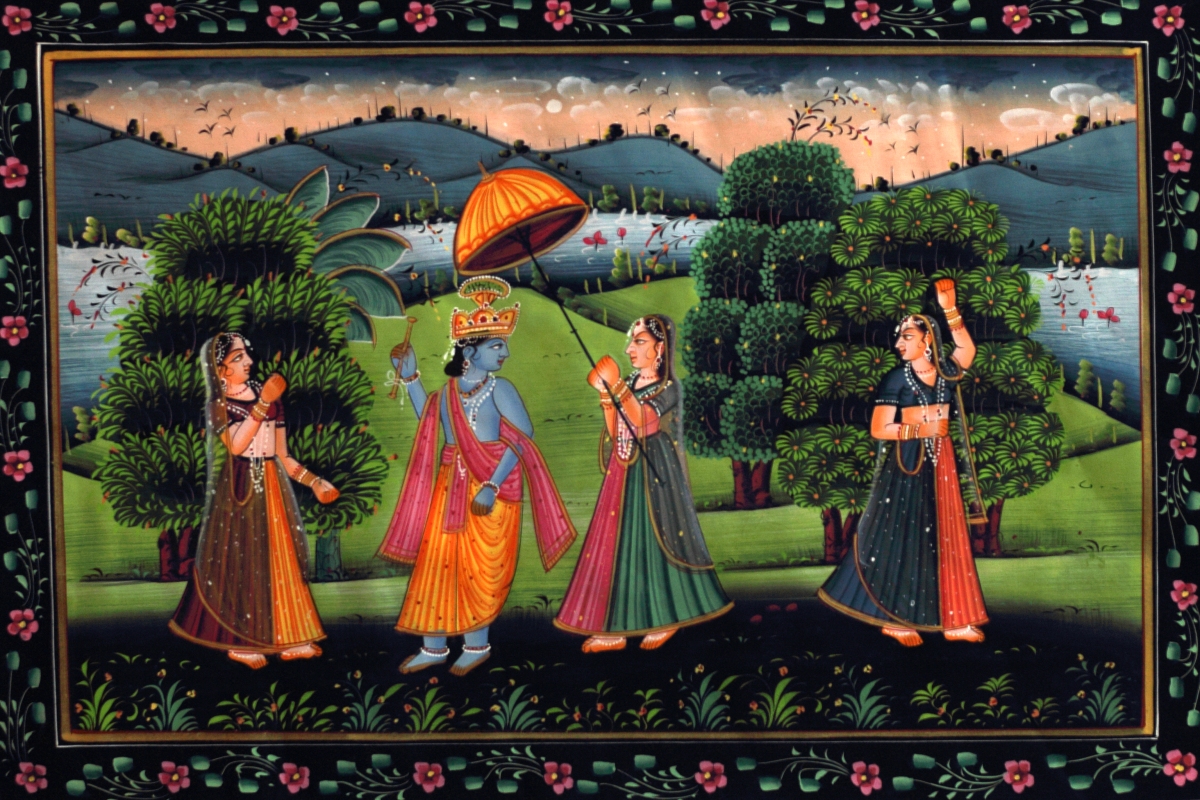
A lifeline that has defined human civilisation. A river that holds a cosmos in itself, a fascinating world of flora and fauna, unseen from above, yet pulsating below, under tranquil waters.
(Pic – Yamuna in Agra. Yamuna is the largest tributary of the river Ganges)
In a land where infrequent monsoons are held as the main season, water is as priceless as a flawless jewel, and rivers are considered sacred. From ancient times when man learned to settle down in what is termed as “civilisation,” water has reigned supreme over man’s life, living, thoughts, writings, paintings, culture, religion, and even wars. Rivers are ancient, and their waters have been flowing persistently even before human beings came into existence. Theirs is a separate universe, a little world of their own, which has sired many tales (mythological and folk), history, religion, philosophy, politics, and also in the modern era, technological incursions. The flowing waters of these mighty rivers have witnessed the creation of some of the earliest cities in the world and have seen their destruction too; they have seen the shaping of some the world’s earliest literature and religious texts and the brilliant minds that shaped those; and now the same waters are witnessing their relentless defiling by the very people that had once started their journey of civilisation on those muddy river plains.

Map of the Ganges valley Source
What’s in a name?
In North India flows a river with many names. Its name is Ganga, rechristened the Ganges by the British, this river is a sacred entity, a focal point of constant reference that entwines life and death for billions of Hindus living in this country since the ancient times.

The blue pristine waters of the Ganga at Haridwar)
Defying what Shakespeare said about a name not being significant, there are some names that certainly spell magic. They create a reverberation in the mind, leaving an impact like an echo. One such name is Ganga.

The name Ganga evokes a vision of evening lamps, temple bells, smell of burning camphor, and the chants of Ganga stotram.

The Bhagirathi peaks from Gangotri. Photo courtesy: Jay Shankar
One may wonder how the name that is so intermingled with the lives of billions, came to be known to the world? Let’s take a quick look back. Studies show that it was during the late Harappan period (2000 to 1000 BCE) that the node of Indian civilisation shifted from the River Indus to the areas adjacent to the upper Ganges basin, a land termed as ‘Cemetery H’ (reference).

The map here shows the names of the rivers, including the Ganges, around which the new settlements grew up, the names of which are found in the Rigveda. Source
The early Rigveda, composed roughly between 1500 to 900 BCE, mentions Jhanavi (Jhanavi is another name for Ganga). However, Ganga gains greater prominence in the later three Vedas. As historian Romila Thapar aptly sums it, “In the Ṛig Veda the geographical focus was the sapta-sindhu (the Indus valley and the Punjab) with Sarasvatī as the sacred river, but within a few centuries ārya-varta is located in the Gaṅgā-Yamūnā Doāb with the Ganges becoming the sacred river.” (reference P. 415).
The first foreign traveller to mention Ganga was Megasthenes (350 – 290 c BCE), in his book Indika, where he spoke of the mighty river and its tributaries, the canal system that helped in irrigation of the Gangetic pain, and its extensive run that ended at Gangaridai (the ancient name for area near the Ganges delta), which he refers to as the land of large elephants (reference).
Ganga also finds mention in Mahabharata, Ramayana, and several Puranas. In Mahabharata she is the consort of King Shantanu and the mother of Bhisma; in Skandapurana she is the consort of Shiva and the mother of Skanda or Kartikeya, also known as Kumara, the son of Ganga. In Bhagavad Purana, Ganga is shown to have emanated from the lotus feet of Vishnu, following which she acquired a beautiful pink shade. With Brahma, she is always seen accompanying him in his kamandalu, as the sacred water. According to a passage in the Ramayana, Ganga is also the daughter of Himavat and Mena, chief of the mountains and his wife, which makes her the sister of Uma/Parvati (reference).

How ancient settlements were centred around the river Ganges and its chief tributary Yamuna Source
The Legend, Mythological representations, and Iconography

The descent of Ganga Source
In Hinduism, Ganga is personified as Devi Ganga, and is in her own self a teertha, a link between heaven and earth. Such is her importance that it is believed that by bathing or taking a dip in her holy waters one is absolved of sins, while immersing the ashes in her waters brings the soul of the dead person closer to moksha. Hence she is often referred to as: Patita Pavani or the liberator of all sins.
In the Indian subcontinent, sometimes other rivers are also referred to as Ganga. This gives the rivers a sacred sanctity that shines through the name Ganga. Its name is also invoked in any ritual where water is used, therefore sanctifying all holy waters used for religious purposes.
Referring to other sacred rivers as Ganga has its own disadvantages too, as is seen in the misconception about the geographical origin of the river. For a long time it was thought Ganga originated in Manas Sarovar near Kailash. While there are no clear theories on how Ganga came to be related to mount Kailash, but one line of thought says that it might have started from an ancient Tibetan text Kailash Purana. A small flowing stream which connects the two lakes, Manas Sarovar and Rakshas tal, is mentioned in the Kailash Purana as Ganga chu (in Tibetan the word chu means river). Could this name have led to the notion that Ganga came from Manas Sarovar? One can only wonder and speculate. However, in 1808 while mapping and tracing the route and origin of the Ganges by Webb and Hearsay, it was specifically proven the river did not originate from Manas Sarovar near Kailash .
The birth of Ganga is beautifully depicted in the Bhagavad Purana, which says that Vishnu in his Vaman avtaar pierced a hole with his left foot at the end of the universe. It was through this hole, the pure Brahm Water came into the universe, in the form of the Ganga River. Since it washed the feet of Vishnu while flowing in, it is also known as Vishnupadi, or the one that emanates from the lotus feet of God. Ganga originally remained in Brahmaloka, until Bhagirath brought her down to the earth in order to release his forefathers from a curse, in what is termed as Ganga avtaran. With Ganga threatening to wash away the earth with her force as she descended, it was Shiva who broke her fall by holding her in his locks and taming her raging waters. There are other legends that give varying versions but this one remains the most popular. Since Bhagirath brought her down, Ganga in the Himalayas is also known as Bhagirathi. From the heaven (swarg or Brahma lok) she descends to the earth or prithvi (via Gaumukh glacier), and finally enters the patal (netherworld) in Ganga Sagar.
As Ganga came down to earth from heaven, she is also seen as the means of moving from earth to heaven. The Triloka-patha-gamini, or the one who traverses the three worlds (swarg , prithvi , and patal), she is herself a teertha, or the crossing point of existence (that includes all living and dead).

Ganga avtaran by Raja Ravi Verma. Shiva readies himself to meet the raging waters of Ganga, while Parvati comfortably leans on Nandi watching the avtaran, and Bhagirath looks on with folded palms.

Ardhanarishwar. Ganga flowing out of Lord Shiva’s matted locks Painting circa 1800 Source

Bhagirath leading Ganga down to Ganga Sagar to release his forefathers who were suffering in patal, Kalighat Patachitra (in print), 19th c. CE. It is believed that Bhagirath led the devi on until Bihar, and when he reached Bengal he wasn’t sure which route to follow that would take him to his forefathers in patal (the netherworld). It was then he requested the devi to take her own route, after which Ganga decided to branch out in streams (in Bengal there are indeed two major streams, Hooghly and Padma, besides other smaller ones). That created the delta formation in Bengal and Bangladesh. Finally one such stream led to a point, now known as Ganga Sagar, which took Ganga to patal, and she released Bhagirath’s forefathers from their sufferings.
In ancient India, Ganga was seen as symbol of fertility, as it provided the daily bread for those that lived on its banks. She is first seen in the Cave V, on a relief in the Udaygiri caves (400 CE), carrying a pot that symbolises fertility ( a womb), as well as the Brahma’s pot from where both she and Saraswati were born. Ganga is accompanied by a gana who symbolises development and attainment. Her vahana is a makara, a mythical figure with the head of a terrestrial animal (such as an elephant) and the lower body of an aquatic animal (generally a fish, sometimes with floral tail like a peacock). Makara symbolises both the underwater life, and the fear of the unknown, the fear of destruction caused by her uncontrolled waters.

By the end of the 5th c. CE, Ganga was seen as a devi in her own right, symbolising all rivers in India, and her iconography turned more complex. All Hindu temples had the goddess carved at the door, symbolising ablution in the sacred waters of the river, as one enters the garbhagriha (the inner sanctum). Ganga on the temple door frame with her vahana, attendants, and the dwarpala ~ at Teli ka mandir, Gwalior fort, 850 c. CE

Ganga in terracotta, 5th century CE. (Gupta Period), Ahichchhatra, Uttar Pradesh. Source

A red sandstone relief, Madhya Pradesh, 8th/9th century. Very finely carved Ganga in a graceful tribhanga at right, adorned with an elaborate knotted belt, standing on a lotus blossom over a rearing makara, along with a retinue of attendants. Source

Makarvahini Ganga, Kalighat Patachitra (in print), 19th c. CE
How the course runs:

Some of the important cities beside the river Ganges as it travels through the northern plains of India and empties itself in the Bay of Bengal near Kolkata (formerly known as Calcutta). It provides water to an area of 8,61,452 Sq.km that is equivalent to almost 26% of the total geographical area in India. Source

Geographically speaking, the Ganga basin is spread over four countries that include India, Tibet, Nepal, and Bangladesh, covering an area of 10,86,000 sq.km. The extensive area of the Ganga basin Source
Casting aside the nitty-gritty of geographical data, let’s peek into towns and cities that line the course of this mighty river.
Gomukh:
At a height f 13,200 ft amidst the snow clad mountains of Uttaranchal, lies of the snout of a glacier from which the waters of the Bhagirathi rush out with great force. Gomukh literally means the mouth of a cow, and finds mention in the Puranas. It is said that the snout of the glacier from which Bhagirathi emerges looked exactly like the mouth of a cow. However, owing to environmental changes, and the glacier changing its position, the shape of Gomukh opening now remains largely left to one’s imagination. Gomukh, which is a two day’s hard trek from Gangotri, is a Hindu pilgrimage site, and it is not surprising to see sadhus and other devotees bathing or taking a dip in the icy cold waters of the Bhagirathi at its point of emergence.

Gomukh, the point of emergence of Bhagirathi at the base of Mt. Shivling. The Gangotri glacier is a receding one, and is moving back at an alarming rate, much to the concern of climate experts. The topography here is rather wild, with hard ice, patches of snow, and large and small boulders scattered everywhere. Picture credit: Saket Kumar

The glacier spout from which Bhagirathi rushes out. Picture credit: Jay Shankar

Base of Mt. Shivling. Picture credit: Jay Shankar

Tapovan at the base of Mt. Shivling, the beautiful meadow through which the Bhagirathi flows after emerging from the Gomukh. Picture credit: Saket Kumar.
Gangotri:
It is a small town at 10, 200 ft, popular among the pilgrims that has a temple dedicated to Ganga devi, which was originally built in the early 19th c. CE by the Gurkha general Amar Singh Thapa. Many sadhus have small kutis here where they stay for most part of the year, pray, and meditate by the riverside. The beautiful, calm surroundings and the sound of the gushing waters of Bhagirathi make it a perfect place for mediation and prayers.

The evening light on Bhagirathi peaks. Picture credit: Jay Shankar

The Ganga temple at Gangotri. The evening arti performed under the open skies beside the river in front of this temple creates an ethreal aura that one has to experience to believe. Picture credit: Jay Shankar

Forceful waters of the Bhagirathi gushing down at Gangotri. Photo credit: Jay Shankar

The Suryakund waterfall in Gangotri located very near to the temple. Here the Bhagirathi falls from a cliff with immense force, making it an unforgettable sight. Photo credit: Jay Shankar

The tranquil waters of Bhagirathi by the side of the Ganga Mandir at Mukhba village (near Harshil), which is the winter residence of the Devi when the temple at Gangotri is shut down on Bhai Ditiya, owing to the heavy snowfall that cuts off the place from the lower reaches during winter. Photo credit: Jay Shankar
Rishikesh and Haridwar:
Bhagirathi from Gangotri flows down the valley passing many picturesque locations such as Gangnani, Harshil, to reach Uttarkashi, which as the name suggests, is another important pilgrimage centre with a Vishwanath temple. Harshil is a Maha Prayag, a confluence of nine rivers, with a Vishnu temple located at the confluence of Jalandhari, Vishnu Ganga, and Bhagirathi. Dharali is another place on the banks of Bhagirathi, where the rivers Bhim Ganga and Hatya Harini meet her. It is believed that by bathing at the confluence of these rivers one is absolved of the sins of even Brahm Hatya (killing of human).

Bhagirathi at Uttarkashi. Photo credit: Jay Shankar
The next important point is Devprayag where Bhagirathi meets Alaknanda, and here the river Ganges is formed. The Ganga which is formed at this confluence contains waters of six rivers, brought in mainly by the Alaknanda that flows in from base of Satopanth and Bhagirath Kharak glaciers, near Badrinath. The waters of Alaknanada contain the rivers Nandakini, Dhauliganga, Mandakini, and Pindar. There are five important Prayags or confluence points on the side of Alaknanda. The five prayags are Vishnuprayag, Nandprayag, Karnaprayag, Rudraprayag, and Devprayag.

The beautiful green waters of Alaknanda (left) merge with the dark waters of Mandakini (right) at Rudraprayag. Mandakini that comes from Chorabari glacier near Kedarnath is an important tributary of the Ganga. Photo credit: Jay Shankar

Devprayag, the birth place of Ganga. On the left is the tranquil Alaknanda, and on the right is the turbulent Bhagirathi . It is here where the Vedic rituals for Shraddh ceremonies and pinda pradaan take place. Source
From Devprayag, the river now known as Ganga, moves down to reach Rishikesh. Here the river leaves the mountains behind and enters the north Indian plains. There are many temples (both old and new), and learning centres for religious education in this town.

This place finds mention in Skandapurana (Kedarkhand), while it is also believed that Rama did penance here in Rishikesh for killing Ravana

The RamJhula in Rishikesh, is a newly built suspension bridge over the Ganges. A little ahead is the more famous Lakshman jhula, where it is said Lakshman had crossed the river using a bridge made of jute ropes. A jute bridge was supposed to have existed in this spot until the late 19th c. CE, as mentioned in his travel records by a famous Bengali travel writer Jaladhar Sen. In 1889, a Marwari businessman from Calcutta sponsored the building of an iron suspension bridge to prevent any further deaths, which was later renovated in 1924 after a major flood.
The next important town beside the Ganga is Haridwar. Here a dam diverts some of the water from the main river to a canal, the waters of which are used for irrigation in the Doab area. The river changes its course from south-west to south east in Haridwar.

Haridwar is one of the seven holiest places in Hindu pilgrimage. The evening aarti at Haridwar by the banks of the Ganga is a site worth seeing despite the crowd that gathers there everyday

Har ki Pauri. It is believed that during samudra manthan, one drop of amrit (elixir) fell on Haridwar in the Brahma Kund, located at Har ki pauri. It is for this reason Haridwar celebrates the Kumbha mela every 12 years, kumbha signifying the pot carried by Garuda, which contained the amrit.

The murti of Devi Ganga at Haridwar. This is the original murti, which has been shifted and kept in a side temple beside the ghat, while the main Ganga mata mandir now holds a murti of the Devi with Bhagirath.

Haridwar as seen and painted by Sitaram in 1814, while travelling with Hastings (then Lord Moira) from Calcutta to Punjab. From a recent record, it has been said that most of the buildings seen here in the picture still exist, however they are covered by ugly advertisement boards and so cannot be seen from the river anymore. The main river seen here has thinned down now owing to the dam built to divert water for irrigation.
Prayag or Allahabad:
From Haridwar the Ganga passes the cities of Kanauj and Kanpur to reach Allahabad, where it meets its chief tributary the Yamuna at Triveni Sangam. Here it is said the Saraswati river was also a part of the confluence. The city was known as Prayag in the ancient times and finds a mention in the Vedas, the Puranas and in Ramayana. Later known as Kausambi, the city according to archaeological finds dates back to 700 BCE. It has seen the coming and going of many empires that include Mauryans, Kushanas, Guptas, Delhi Sultanate, Mughals, Marathas, and lastly the British. During Mughal rule, Akbar renamed the city as Illahabad, and built a fort on the banks of the Sangam. The British later changed the name to Allahabad.

A bridge of boats on the Ganges in Kanpur (then Cawnpore), with two elephants crossing it. A bungalow, few temples, and Sarsaiya ghat are seen on the right side of the bridge on the banks of Ganga. The picture was painted by Sitaram in 1814, while travelling upstream on the Ganga in a bajra with Hastings (then Lord Moira) from Calcutta.

The Ganga at Prayag. Photo credit: Gency Chowdhury

The Yamuna at Prayag. Photo credit: Gency Chowdhury

Prayag during Kumbh mela. Photo credit: Gency Chowdhury

Prayag during Kumbh. Photo credit: Gency Chowdhury

The Allahabad fort built by Akbar at the Sangam. On the left is Yamuna and on the right is Ganga. Far left in the picture, partly seen is a white building which is most likely the Akbari masjid. The magnificent white octagonal structure in the fort seen here from the river, was known as Chalees Satun, and it was destroyed by the East India Company who took over in 1798. The picture was painted by Sitaram.
Chunar Fort:
After Allahabad the next important city beside the Ganga is Varanasi or Kashi. Between Prayag and Kashi lies the important fort of Chunar on the banks of the Ganga. The fort has been linked to king Bali, Vikramaditya of Ujjain, and Prithviraj Chauhan. While archaeological finds place the fort settlement date at around 56 BC, recorded history starts from the time of Babar. It was taken over from the Mughal subedars by Sher Shah, who married into the subedar family. The fort was won over from him by Humayun, only to be again taken back by Sher Shah. Akbar won it back in 1574, and it remained with the Mughals until the East India company conquered it in 1722.

Chunar fort. After East India Company took over the fort in 1722, they faced stiff resistance from Raja Chait Singh of Benaras in 1781. In 1791 the fort was made into a sanatorium for the sick and dying European soldiers. The picture was painted by Sitaram
Varanasi/Benaras or Kashi:
The name Varanasi rises from the two tributaries of the Ganga that bind the old city, rivers Varuna and Assi. Rigveda mentions the city as Kasi, which in Sanskrit means the city of light. Regarded as one of the holiest cities, Kashi or Varanasi was supposedly built by Shiva, and it is here that the Pandavas came to search for Shiva in order to atone for their killings during the Kurukshetra war. Buddha also started his preaching from Sarnath, a place very near to Varanasi, which was the capital of the Kashi kingdom during his time. Archaeological findings place the start of settlement in this city at around 2000 BCE (reference). The city is also well known from the ancient times for its religious learning centres, textiles (Benarasi weave on silk is famous), sculptures, ivory, and perfumes.

Such is the religious significance of this city that it is believed that if one is fortunate enough to die in Kashi, that person will attain moksha. Photo credit: Gency Chowdury

Ganga aarti on a ghat in Benaras. Photo credit: Gency Chowdury

The riverfront at Benaras with Panchganga ghat at the centre, and Aurangzeb’s mosque rising above it. The mosque minarets were later removed because of of their instability. Painting by Sitaram in 1814.

Dasasvamedha ghat in Benaras. The building seen here is the rest house built by Rani Ahalya Bai. Painting by Sitaram in 1814.

The palace of the Raja of Benaras that was constructed in 1750 by Raja Balwant Singh. He was the governor of Benaras under the Nawab of Oudh. The Nawab transferred the sovereignty of the city to the East India Company in 1755. Seen above is the State Boat of the Raja of Benaras. Painting by Sitaram.
From Varanasi, Ganga travels further on, crossing the states of Bihar and Bengal. This part of the journey however, will be told another day.  For now, I will leave you at Kashidham with Ganga, where the Devi makes a lovely arc and turns uttarvahini.
For now, I will leave you at Kashidham with Ganga, where the Devi makes a lovely arc and turns uttarvahini.
Author – Monidipa Bose
She can be contacted at monidipadey@rocketmail.com or at Moni Gatha
(All pictures used in the post are clicked by the author unless mentioned otherwise. Sita Rams’s paintings and pictorial details are from J.P. Losty’s Picturesque views of India: SitaRam)












































































































 For now, I will leave you at Kashidham with Ganga, where the Devi makes a lovely arc and turns uttarvahini.
For now, I will leave you at Kashidham with Ganga, where the Devi makes a lovely arc and turns uttarvahini.































































































